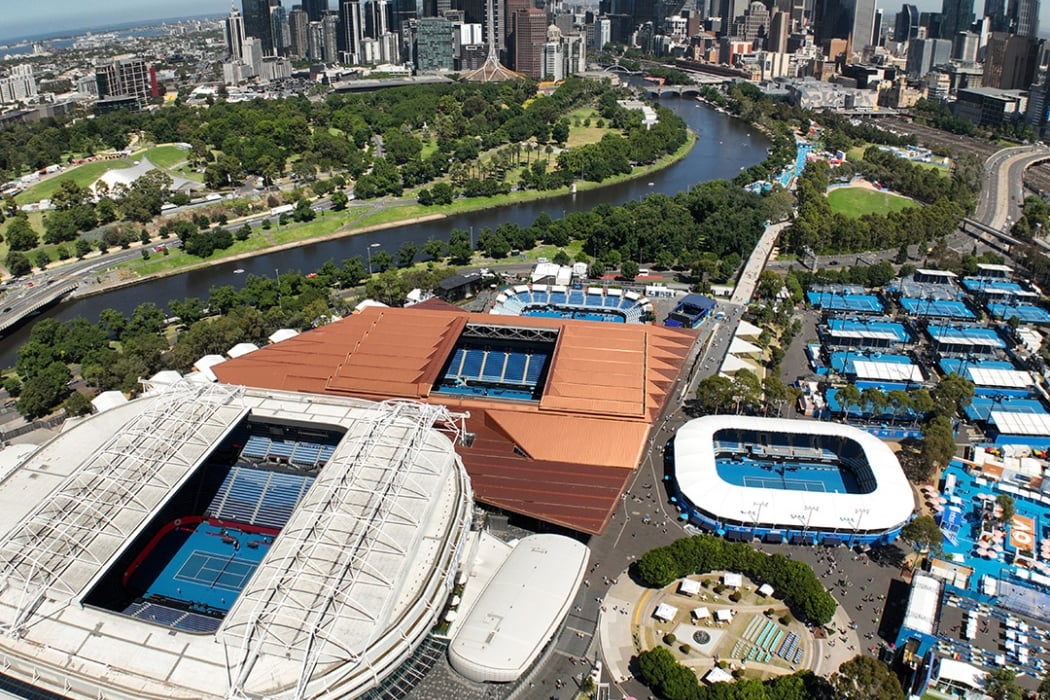Rod Laver Arena’s primary purpose, when it was built in the late 1980s, was to serve as the Australian Open’s Centre Court.
The arena was the centrepiece of the newly-constructed National Tennis Centre, which became the AO’s new home after its final edition at Kooyong in 1987.
However, it is not only a tennis venue.
Unlike the centre courts at other Grand Slam venues, Rod Laver Arena regularly hosts world-class music, entertainment and non-tennis sporting events – a true multi-purpose venue. These events are staged throughout the year from mid February to mid December.
After the last concert is held – which in 2023 was on 10 December – Australian Open organisers take over the venue to ensure it is ready for when the world’s best players arrive to begin their tournament preparations.
In just over two weeks, an arena which has staged a sold-out concert is de-rigged and bumped out, re-surfaced, then fitted out with the necessary tennis paraphernalia – all in time for the first player practices.
Here’s how it happens.
Bump-out
Concert infrastructure is removed from the arena following a show, which includes the stage, rigging and any other production equipment installed by the touring company putting on the event.
But the biggest task is removing the rigging grid from Rod Laver Arena’s ceiling, so that the roof can open and close during the Australian Open.
READ MORE: The kings and queens of Rod Laver Arena
During concerts, the roof remains closed so the rigging grid can be fixed in place, from which lights, speakers and cabling hang.
Removing this is a six-day process, and when not in use, it’s stored beneath the stadium in a cavernous space big enough for large trucks to enter and exit.
Court resurfacing begins
When the venue is used outside of tournament time, a layer of plastic, then general-purpose flooring (which locks into place) is laid over the court to protect against major dints and scratches.
This flooring is removed once the last concert is completely bumped out, revealing the tennis court surface beneath, which is then assessed by the AO court services team.
The court is scraped back to the base layer; allowing paint to build up year-upon-year would prevent the year-round floor locking into position.
The court is then prepared with two layers of paint on the inside of the court and two on the outside, followed by the painting of the lines – the final layer.
This process requires five dry days to complete, but thankfully, the team has the roof as a trusty back-up in case of wet weather.
Seating reconfigured
In concert mode, rows of seats in Rod Laver Arena’s southern section are folded down, stacked on top of one another and retracted to make way for the stage.
Concertgoers sit on the remaining three sides, while the floor in front of the stage is used for standing room or additional seating, depending on the show.

While still retracted, court furniture such as umpires’ chairs and player benches is brought into Rod Laver Arena on pallets.
Given the court resurfacing process is still underway, protective black plastic and carpet tiles are laid so the respective teams can work in tandem.
With the stage removed during bump out, these southern seats are eventually returned into place, allowing Australian Open spectators to sit on all four sides of the venue, surrounding the court.
Installation time
As soon as the court is resurfaced, LED walls are the first things to be installed.
Because these are not in place year-round, they are custom-built each year for the AO, assembled piece by piece on the three-metre-high walls separating the sunken playing surface from the first row of seats above.

Approximately 500m2 of LED panels are installed by between 15 to 20 specialised crew, a process typically taking around four to five days to complete.
Logistically, there are challenges. The team must work carefully over the freshly-painted court, and seamlessly fit a section of the LED panels around the commentary booth. An inner guard layer is also incorporated into the design, protecting the LED signage from the impact of tennis balls.
‘Tennis ready’
In the final days of the transformation, the last puzzle pieces are added to ensure Rod Laver Arena is ready for Grand Slam play.
MORE: Australian Open 2024 entry lists revealed
The LED technology is not limited to the walls; the team also installs custom-designed panels into the umpire’s chair and builds four large scoreboards on the ground, which are then rigged into position and suspended from the roof. A second tier of LED panels – for displaying scores, stats and branding – are installed above each of the 20 entry doors ringing the concourse inside the arena.
Elsewhere, photographers’ platforms are installed alongside the court, spider-cam wiring is assembled high above, and the catwalk is rigged with screens, broadcast equipment and Hawkeye cameras.
The catwalk is another area photographers can access, for spectacular birds-eye-view shots.

By this time, top players may have already arrived in Melbourne and begun practising on the freshly-surfaced court, as these finishing touches are being installed around them.
By the New Year, Rod Laver Arena is ready to go.
An entertainment venue again
Following the Australian Open, Rod Laver Arena – as well as Melbourne Park’s other venues – is returned to year-round managers Melbourne & Olympic Parks (M&OP), who begin preparations for their calendar of events.
Bump out in Rod Laver Arena begins just hours after the men’s final concludes, with the venue handed back to M&OP five days later.
From mid-February, Rod Laver Arena is ready to host concerts again.
In 2024 the venue will welcome the likes of Blink 182 – the first concert held after the AO, on 13 February – plus Matchbox Twenty, Jerry Seinfeld and more.

